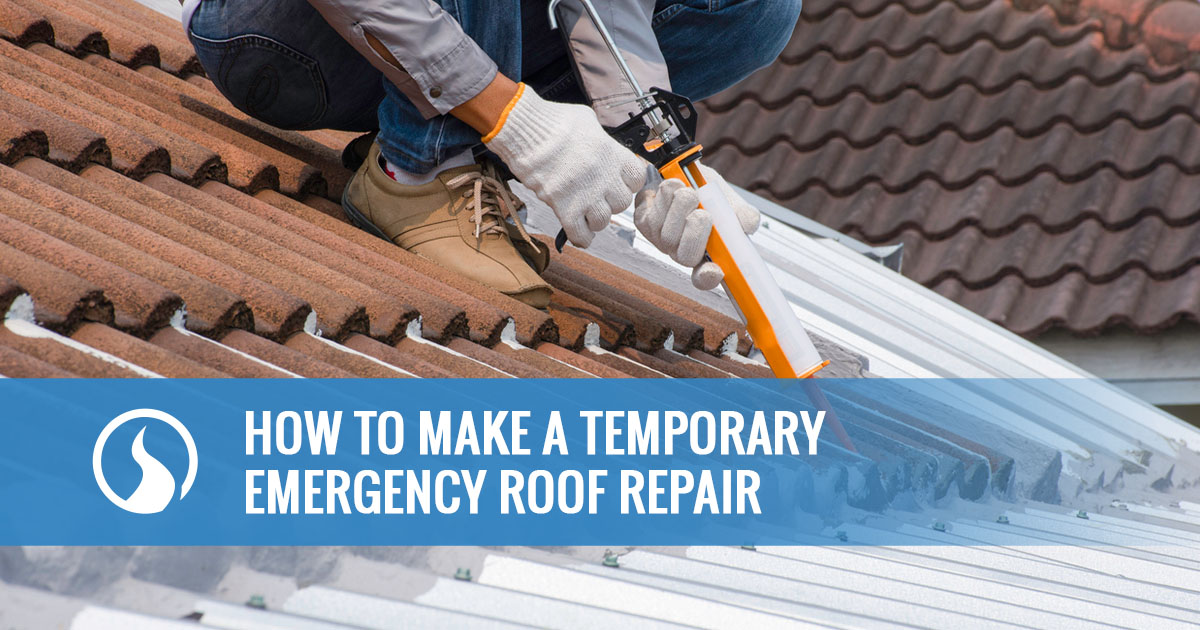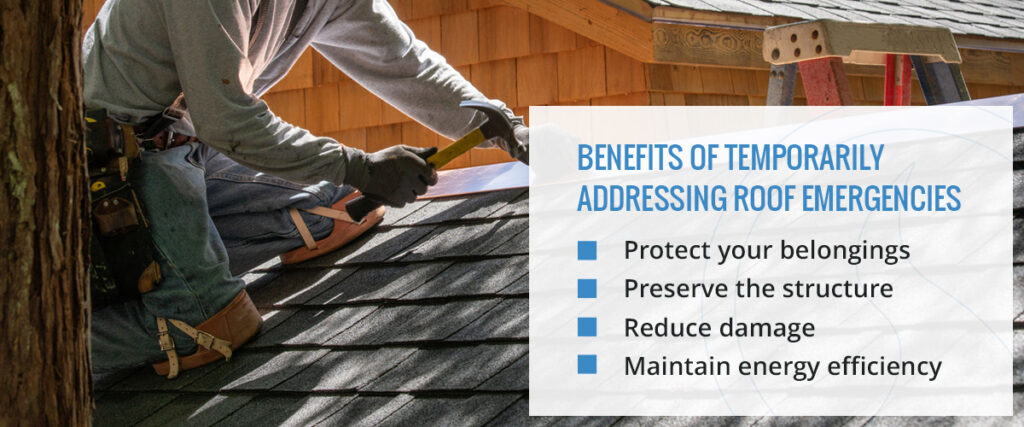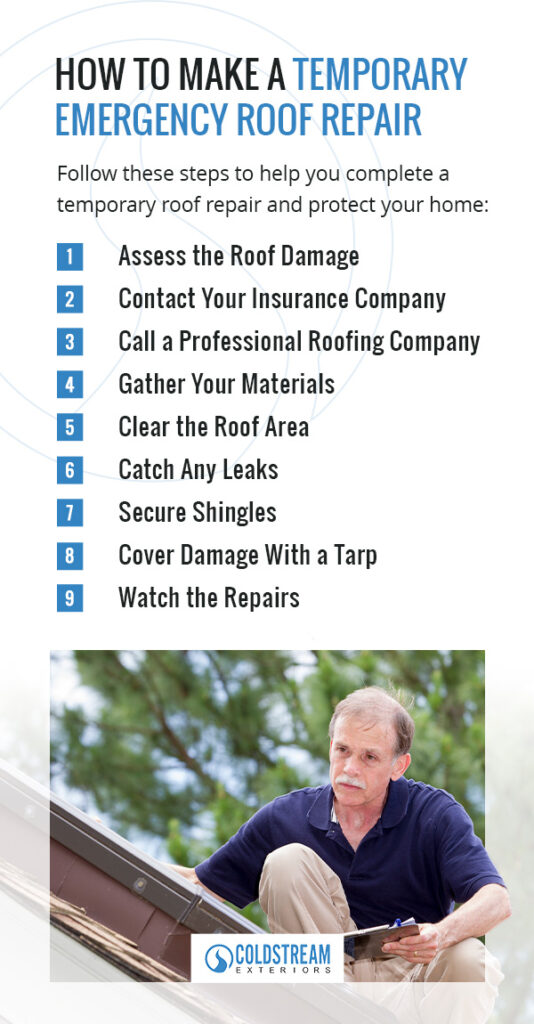Crafting a Temporary Emergency Roof Repair When Disaster Strikes

Roof damage can leave you with constant leaks, missing shingles and structural issues. When dealing with a roof emergency, you must act quickly to minimize damage, expenses and stress.
Learning how to complete temporary roof repairs can help reduce roof damage and protect your home after an emergency. While you always need to schedule professional roof repairs after roof damage, putting temporary measures in place can help ensure your home stays safe and comfortable until roofing contractors arrive.
Types of Emergency Roof Repairs
Damaged roofs can lead to significant financial and safety issues if left unaddressed. Roofs contain several components that work together to maintain your home’s strength and security. While some repairs should always be left to the professionals, you can make some temporary changes to help protect your home.

Here are some of the emergency roof repairs you might find yourself making:
- Securing shingles: Loose shingles need securing so they don’t fly away and expose your roof underlayment. Securing them should be done as soon as you notice the issue. Carefully lift the nearby shingles and use screws or roofing nails to fix them into place, then apply a sealant to keep water out.
- Replacing shingles: If your shingles are missing entirely, you’ll need to replace them temporarily. Using spare shingles or any similar material you have, follow your manufacturer’s instructions to install your temporary shingles correctly. With replacement measures secured, you’ll temporarily maintain your roof’s waterproofing and protect your home.
- Patching leaks: A leaking roof is an emergency — leaks cause mold, water damage and property loss. Leaks are one of the most common emergency repairs homeowners see. While you’ll want a professional to perform the final repairs, it’s essential to plug the leak as soon as possible. Follow the leak upward to find the source. Then, use caulk or roofing sealant generously over the entire area to temporarily stop the leak.
- Sealing gaps: Gaps and cracks in your roof will let water inside, leading to interior damage and mold if left unchecked. In many cases, mold growth can impact your and your family’s health, making mold prevention vital. Once you spot these gaps, use caulk or roofing sealant to seal these areas temporarily. Covering the entire damaged section thoroughly will help prevent water from getting in until more permanent measures are implemented.
- Tarping damage: Temporary tarps are ideal for more extensive roof damage you need to cover immediately. Tarps and plastic sheets are waterproof and work well in emergencies. Take your tarp and secure it at the highest roof point you’ll cover. Carefully attach the tarp past the damage to undamaged roofing sections with screws or nails. This arrangement helps make sure no water seeps in through the gap between damaged and undamaged sections.
- Clearing debris: Storms can blow damaging debris like fallen branches onto your roof. Debris can cause impact damage immediately or wear down your roof over time if it’s allowed to sit on the structure unchecked. If you can safely do it, carefully remove debris from your roof to prevent further damage. Be cautious and always have someone watching you.
These roof repair measures are only temporary, and you should always follow them up with permanent professional services. Contact a professional roofing contractor for a damage assessment — they’ll tell you what the scope of the damage is and what they recommend as a long-term solution. They’ll help you get the necessary repairs to ensure your home stays safe.
Also, remember that roof work is dangerous, especially in emergency conditions. If you feel uncomfortable working on your roof or don’t have experience with emergency roof repairs in St. louis or Cincinnati, you should seek emergency professional assistance for your roof issues. It’s better to stay safe if you’re unsure than to risk your safety performing roof work.

Benefits of Temporarily Addressing Roof Emergencies
Addressing roof emergencies as soon as possible has many essential benefits for homeowners. Taking the correct steps to patch up repairs temporarily will help save you time and money in the long run while reducing your stress around the repairs you’ll need to schedule.
If you want to protect your home after roof emergencies, temporary repairs will help restore your peace of mind. Some of the benefits you can expect from completing temporary roof repairs include:
- Protect your belongings: Your home and belongings are at risk of water and weather damage with a compromised roof. Your home is essential to your life and is a highly valuable asset — damage to it and your belongings can set you back thousands of dollars and leave you with lots of stress. Temporary repairs are critical for protecting your belongings and home. They’ll help keep water, bugs and weather out so your things stay dry and safe. You can save your investments and remain comfortable with temporary repairs.
- Preserve the structure: Roofs are essential for maintaining your home’s structural integrity. If compromised, it can lead to other severe issues like sagging sealings, weak supports and even collapses. Eventually, you’ll end up with even more damage and expenses than you initially had. The faster you address roof emergencies, the safer and more stable your home will be.
- Reduce damage: Acting as quickly as possible helps reduce home damage. If structural issues or leaks are allowed to sit, they’ll spread and weaken other areas of your home. Water damage especially will spread if left unchecked. Your paint, walls, ceilings, floors and belongings will all take on water damage, and you can even get mold. If you get emergency repairs in place after scheduling a professional service, you’ll save money and lower the risk of damage.
- Maintain energy efficiency: Your roof helps maintain your home’s energy efficiency, keeping the temperature consistent and preventing outside elements from getting in. Any leaks, gaps, cracks or holes can allow air to escape through the roof, and your energy use will rise as your HVAC tries to keep up. It’ll use more power to work harder, raising your energy bills. By making emergency repairs, you reduce air loss and limit excess energy use.

How to Make a Temporary Emergency Roof Repair
Damaged roofs can cause severe issues during harsh weather or emergencies. If you need emergency roof repair, it’s essential to put measures in place to minimize the damage. Once you notice a roof emergency, you should act quickly to reduce long-term damage.
Follow these steps to help you complete a temporary roof repair and protect your home:
1. Assess the Roof Damage
Carefully inspect your roof for any damage. Look inside and on the exterior to understand the full scope of the issue. Check for wet spots, leaks, missing shingles, structural damage or any other problems with the roof that need correcting. You might need a ladder to get onto the roof to check thoroughly. Additionally, watch out for nearby damage to your home or wiring — these issues could pose a safety risk.
After making note of all the roof damage you’re dealing with, try to identify the areas that require the most immediate attention. The worse the damage is, the higher of a priority should be. You’ll need to address these issues first to decrease long-term damage.
2. Contact Your Insurance Company
Your insurance company will need to know about the roof damage. Depending on your coverage, your policy can help cover some of the costs and repairs. Contacting your insurance company will help you determine what damages they’ll cover and can help win you your claim down the road.
Take photos of all the damage to help with your insurance claim. Insurance companies usually advise customers to get a professional contractor to survey the damage. Additionally, they’ll send out an inspector to verify your claim and observe the damage’s extent.
3. Call a Professional Roofing Company
After contacting your insurance company, you’ll need to get in touch with professional roofers. You always want a professional opinion to help you understand the damage and improve your chances of a successful insurance claim.
Once you’ve contacted the roofing contractor, they’ll schedule an inspection and a repair appointment. Getting a roofing inspection will allow you to fully understand the damage and what you’ll need to do to correct the issue and protect your home.
4. Gather Your Materials
You’ll need to get all your materials together before beginning any emergency repair work. Ladders, tarps, screws, nails, plastic sheeting, drills, caulk, roofing sealant, hammers, buckets and utility knives might all be needed. Additionally, you’ll want to get safety equipment for the job, like goggles and gloves. You should try to get someone else to help spot you while you’re on top of the roof to have an extra layer of safety for the project.
5. Clear the Roof Area
Make sure the roof and all surrounding areas are clear of debris and obstacles. Clearing the area to the best of your ability helps keep you safe while working and helps prevent debris from getting in the way of completing emergency repairs. Loose objects can make the project more dangerous and slow the repair process.
6. Catch Any Leaks
Once you’ve contacted your insurance and roofing company and cleared away debris, it’s time to start repairs. A roof leak is an emergency in most cases. It’s critical to catch any leaking water before plugging the leaks to help prevent water damage from spreading further. Then, you can begin to seal the gaps.
Completely seal any openings to stop water and air from getting inside. Catching the water and filling the holes will give you the best-possible temporary protection until you can get professional roofing services. If you don’t feel comfortable sealing up the gaps yourself, you should still use buckets to catch the leaking water and prevent further water damage.
7. Secure Shingles
If you spot any loose or missing shingles during your roof inspection, secure them to protect your roof temporarily. Remember, if you’re unsure about doing this yourself, it’s always best to contact a professional roofing company that offers next-day repair services.
Once on the roof with your materials, you should carefully lift the surrounding or loose shingles. Use your roofing nails or screws to secure the shingles in place. If you’re dealing with missing shingles, secure a similar material or extra shingle over the gap. You can further improve their protection by adding waterproof sealant.
8. Cover Damage With a Tarp
Covering smaller and large damaged areas with a tarp is an efficient way to seal your roof temporarily. Tarps provide immediate, waterproof protection to damaged roof sections. Emergency roof tarping costs vary, but you can look for affordable temporary options at your local hardware store.
Secure the tarp to the highest part of the roof above the damaged area. Spread it out and secure it with screws or nails. Ensure the tarp covers the damaged area and the non-damaged area next to the damage — this keeps water out and helps prevent new damage from forming before professional roofers get there.
Try to secure your tarp as safely as possible. It can be dangerous to get on your roof and attach a large sheet of waterproof material, especially if no one is assisting you.
9. Watch the Repairs
While waiting for your professional repair date, keep a close eye on the temporary repairs you’ve made. Monitoring the repairs will let you catch any damage or issues early, especially during severe weather. If you notice your temporary repair failing, contact your roofing company to ask about emergency repair services.

Expert Roof Repair From Coldstream Exteriors
Coldstream Exteriors has delivered high-quality roof repair and replacement services to homeowners for over 25 years. At Coldstream Exteriors, we understand the importance of maintaining a safe, strong roof — that’s why we offer 24/7 emergency roof repair services in Cincinnati and St. Louis, industry-leading warranties and low-financing options to our customers.
If you’re in the greater Cincinnati, St. Louis or Tampa areas, trust our expert team for all your home exterior needs. Get started with your free inspection today.
